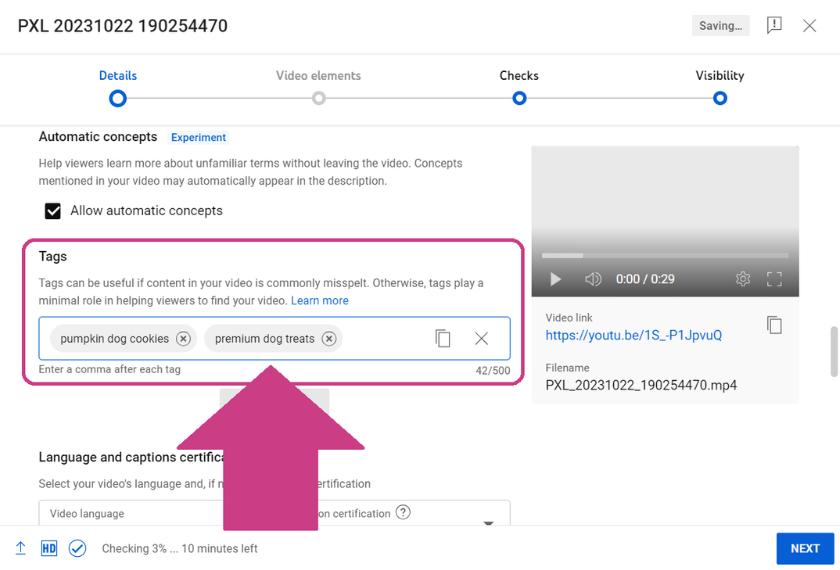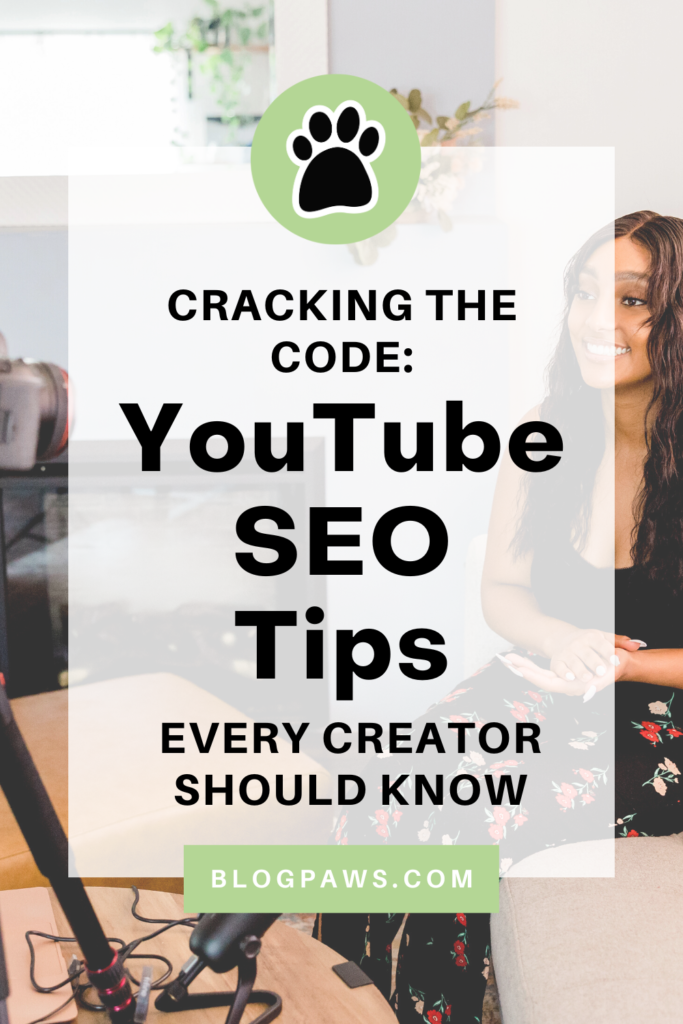Cracking the Code: YouTube SEO Tips Every Creator Should Know
We often talk about the importance of Search Engine Optimization (SEO) to help your blog content reach your target audience. But blogging isn’t the only part of your marketing plan that should incorporate SEO. As a content creator or small business owner, you must consider how to position yourself in search on each platform. This includes the use of YouTube SEO to grow your YouTube Channel.
But what is YouTube SEO, and how can it help your business?
Let’s take a deep dive into the basics of SEO for YouTube, including what it involves, best practices for creating a YouTube SEO strategy, and tools to help you along the way.
What is YouTube SEO?
Let’s start with the basics – understanding what YouTube SEO is and how it can benefit your business.
SEO refers to creating content (blog, video, etc.) optimized to improve the chances that your website or social content will perform well when someone is searching for terms or questions related to your business.
If you have been around the BlogPaws Community for any length of time, you have heard us talking about the importance of writing your content with SEO in mind (although it’s not the ONLY thing you should have in mind). You could create the best, most amazing content on the planet, but it isn’t going to help your business if no one sees it…
The same can be said about your YouTube video creation!
You can make an INCREDIBLE YouTube video that solves the most challenging struggles pet parents face, but it won’t change the world of pet ownership if no one views it. By making some strategic decisions when creating and publishing your video, you can increase the likelihood of your content being shown in the search results on YouTube as well as on Google’s search results.
How to Do SEO on YouTube
Now that we have established that YouTube SEO is essential to using the platform to reach your potential customers, let’s dig into some actionable SEO tips for YouTube. These recommendations all follow the YouTube SEO best practices while positioning you and your small pet business to grow and thrive in your video marketing.
Find Relevant Keywords
When selecting YouTube SEO keywords, ensure they are relevant to your business. Generating a lot of uninterested traffic won’t help you make sales any more than generating no traffic at all.
Take a moment to consider what your target audience may be searching for. If you’re unsure where to begin, try asking family and friends or polling your community. This could be a short phrase like “healthy, gluten-free dog treats” for a dog treat company or a question like “how do you safely deal with matted hair in cats” for a cat groomer.
Don’t Forget Search Intent
Selecting the best keywords to drive your SEO efforts involves more than just finding phrases that offer high traffic volume with low competition (although that is a great starting point). You also need to take a moment to consider the search intent associated with each phrase.
To discover search intent, try searching the phrase you are considering in an incognito window on Google or YouTube. Do the results align with your offer?
If you are trying to sell dog treats and the term “pumpkin dog treats” returns results that are all focused on making homemade dog treats, you may want to keep looking. This tells you that the people using that specific term are interested in making their treats, meaning they aren’t interested in purchasing. Find keyword phrases where the search intent aligns with your target market.
Create an Optimized and Catchy Video Title
The first place to incorporate your main keyword is in the title of your video. You want to create a title that flows naturally with your keyword while giving the viewer a reason to click through and watch the video.
The optimal place to include the keyword is at the beginning, but don’t sacrifice readability for search optimization. Always create content for people first and search engines second!
For example, using the keyword phrase “enrichment toys for dogs”:
- Good: 12 Enrichment Toys for Dogs That Will Make Their Tails Wag!
- Bad: How to Keep a Hyper Dog from Destroying Your House, Enrichment Toys for Dogs
Write an Optimized Video Description
Your video description can be optimized for search like a blog post. Include your target keywords in the text in a way that flows naturally and accurately relates to the video content. This is prime real estate for ensuring that your keyword is clear to YouTube and Google’s bots as they crawl and index the content.
Try to include your main keyword in the first 25 words. Here, you can also include secondary keywords relevant to the video. Avoid using the keyword too often or writing poor-quality content just to fit in as many keywords as possible. These outdated practices are considered keyword stuffing and do more harm than good!
Categorize Your Video Properly
When uploading your video, you will be given the opportunity to select a category, as shown in the screenshot below. Take a moment to read through the options and ensure that you choose the most relevant category for your content and business.
For small pet business owners, “Pets and animals” is the obvious choice. However, there may be times when another category is more relevant for reaching the ideal audience.
Name Your Video File with SEO in Mind
Did you know that the name of your video file also impacts your SEO efforts? Renaming your video to include your main keyword can help the platform better understand what the video is about, increasing your chances of ranking for that phrase.
Rather than uploading “vid_1234,” try renaming your video so that you are uploading “best_pumpkin_dog_treats” instead.
Speak Your Keywords Clearly
During your video, make sure to say your keywords, and be careful to enunciate them clearly when you do. More specifically, try to include your main keyword in the introduction of your video.
YouTube transcribes all videos uploaded to the platform so that they can deliver captions for better accessibility. This is another place where you can include your keyword to communicate to clarify the topic of the video within the search algorithm.
Use Relevant Tags
Another feature available when uploading your videos are tags. Tags help YouTube better understand your content and what phrases may describe it accurately. Include your primary keyword and any secondary keywords as tags. If you’re unsure of what tags to use, consider using a tool like the YouTube Tags Chrome Extension to view the tags used by your competitors.
Prioritize Watch Time
Pay careful attention to your account analytics and take note of your watch time. If everyone who clicks through to see your video quickly clicks away, that is telling YouTube that your content is poor-quality or uninteresting. Moving forward, this will mean your video is less likely to show up in search results.
If you have low watch time, take note of where the viewers are dropping off. Are they leaving after a couple minutes during a long montage? Are they leaving during a long talking section of the video? This could indicate that you need to reconsider your editing and video structure to keep the video interesting and engaging.
Learn and improve as you continue making content. Test different approaches until you find a video format and style that connects well with your audience.
Add Timestamps to Your Videos
Timestamps and chapters are used to break up a longer video, creating a better user experience. This will help to encourage viewers to continue watching your content, know what to expect, and anticipate upcoming topics. In turn, you will notice an improvement in your watch time.
This feature can also help improve the click-through rate of your videos in search, as the timestamps are displayed as a drop-down feature in the YouTube search results. They provide more information to convince viewers that your video is exciting and worth watching.
Create an Eye-Catching Thumbnail
On the topic of click-through rates, one of the most valuable tools to improve this stat is your thumbnail. If someone sees your video in the search results or the related videos sidebar, they are only given two pieces of information – your video title and the thumbnail. Is that enough to convince them to click and watch your video?
While this may not fall directly into your YouTube SEO plan, improving your click-through rate can definitely help to improve your overall search performance!
Include Cards and End Screens
Cards are clickable links included during your video, leading to a related video, playlist, YouTube channel, pool, charity, fundraiser, or website. This may seem counterproductive as there is a chance you are leading traffic away from the platform. However, cards can improve your overall engagement and watch rates by leading viewers from one video to the next. The more people watch your videos, the better YouTube will view your content quality.
Check out this video from YouTube to learn how to use cards effectively in your content:
Include 2-3 Relevant Hashtags
There are many conversations and much debate about using hashtags on platforms like Instagram, Facebook, and TikTok – but where does YouTube stand? While you shouldn’t create a long list of hashtags to add to every video, including 2-3 hashtags on each video can help to attract viewers interested specifically in the topic of your content.
Up to three hashtags included in your description will be highlighted by the video title. When focusing on SEO for YouTube videos, this is a great way to help the platform understand your main topics. In terms of user experience, it makes it easy for them to move from video to video within a specific niche or topic.
Pin a Conversation-Driving Comment
After posting your new video, consider dropping a comment that ignites conversation around your niche or the specific topic of the content. Like most social platforms, the higher the engagement, the better your content will perform. Why? YouTube views engagement as a signal that a video offers value and is, therefore, high-quality. The more conversations you can inspire, the better you will perform (in theory) in the search results.
Embed Videos in Relevant Blog Posts and Landing Pages
Another great way to boost your watch time on your YouTube videos is to embed them on relevant blog posts and landing pages.
How does this help with watch time? The people who come across these posts or pages are doing so because they are interested in the topic. Maybe they found the page because of a Google search or clicked through to a blog post from a Facebook page post. The fact is, they were interested in the topic and clicked through for more info. Their investment in the topic means they are more likely to watch the full video (or at least a good portion of it), which will increase your watch time.
Create Playlists of Videos with Similar Topics
When you create playlists on YouTube, you show the platform that you have covered various topics relating to the same niche or area of interest. For example, you could have shared several healthy dog treat recipes or a list of dog engagement product reviews. This helps YouTube recognize your authority on the topic and provides a clear path for viewers to take from one video to the next.
The good news is that you can add one YouTube video to several relevant playlists. This means you can create connections and create a web of content that satisfies both the YouTube algorithm and the needs of your viewers.
Optimize Your Channel Page
Not only should you prioritize SEO on your videos, but you should also pay careful attention to SEO for YouTube channel performance. Ensure you have completed your YouTube channel page, filling out all relevant information about your channel, including the description and corresponding links.
In your channel description, include 1-3 keywords relevant to your content. For example, if your videos are product reviews about different canine enrichment products, each video should be optimized for keywords relevant to that product specifically. However, your channel may be optimized for “canine enrichment” or “canine enrichment products.”
Don’t Overlook YouTube Shorts SEO
Many platforms are now emphasizing short-form video, and YouTube is no exception. If you want to leverage the power of YouTube SEO, you must also consider how to incorporate relevant keywords into your YouTube Shorts videos. Include your keywords in the description, your spoken words, and the words you add on screen. This is a great way to reach new viewers in your target audience.
Best SEO Tools for YouTube
There are several tools you can use, both free and paid, to support your YouTube SEO efforts.
To begin, leverage the SEO YouTube tools available within the platform. YouTube analytics can help you better understand your audience and how they engage with your videos; YouTube search results can show you which videos are performing well; and YouTube’s autocomplete feature can help you identify common keywords and phrases used on the platform. These are all freely available, so don’t overlook the value they offer.
Looking outside of YouTube, another free SEO tool for YouTube that you should consider is Google Search Console (GSC). By entering a YouTube channel into GSC, you can access specific data related to your YouTube performance, including your average position of your videos in YouTube search, impressions, clicks, and top-performing keywords. This information can help you improve your overall performance on the platform.
Finally, there are several third-party SEO tools for YouTube. These tools often provide comprehensive, user-friendly dashboards with detailed information to help you grow your YouTube account. Both Tube Buddy and vidIQ offer great SEO tools for YouTube research and analysis. They provide unique insights and data that can help you improve and adapt your videos to improve search performance.
Final Thoughts on How to Do YouTube SEO (and Why it’s Important)
Don’t sleep on the importance of YouTube SEO in your content creation. The actionable steps we listed above, including effective keyword research, addressing search intent, and writing optimized video descriptions, are the “secret sauce” that can help you take your video marketing to the next level. While improving your YouTube SEO ranking won’t automatically guarantee sales, it does provide you with a larger audience to nurture and share your product/service with.
SEO doesn’t have to be complicated, and it doesn’t have to break the budget. You can start small and focus on one of the above tips at a time if necessary. Get started today and soon you will see all your hard work pay off!
About the Author: Britt Kascjak, BlogPaws Director of Content & SEO, is an award-winning freelance writer whose background in digital and social media marketing spans 15+ years. She’s been a content creator in the pet industry for 9+ years with her own blogs: Shed Happens, The Kas Pack, and Lucifer the Rescue Pup where she shares her life and outdoor adventures with her 2 dogs and 3 cats. Read more…








One Comment